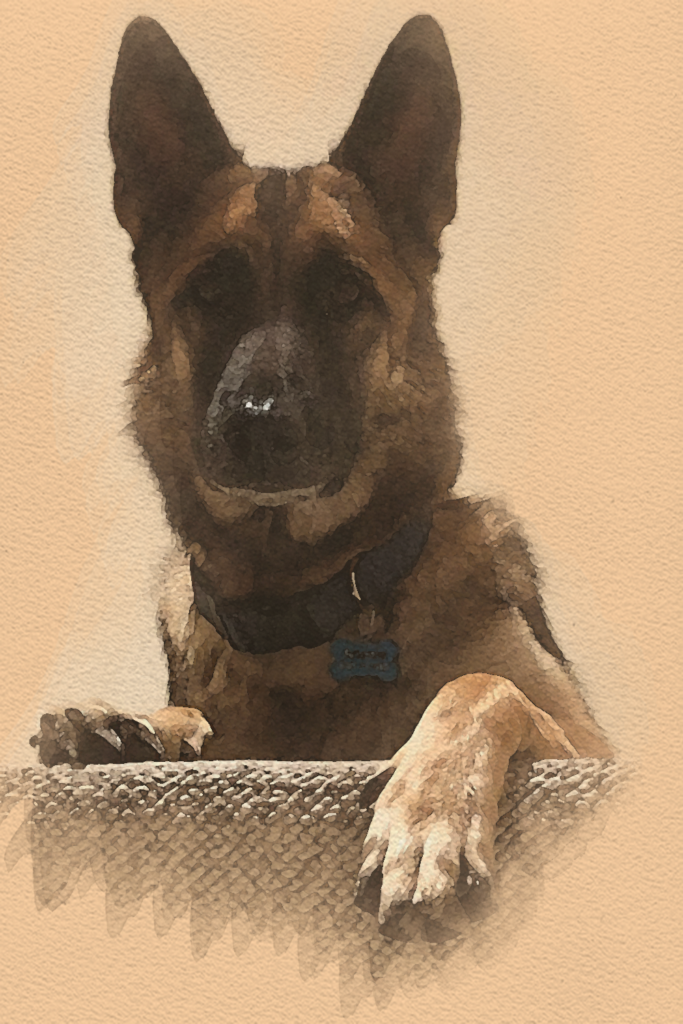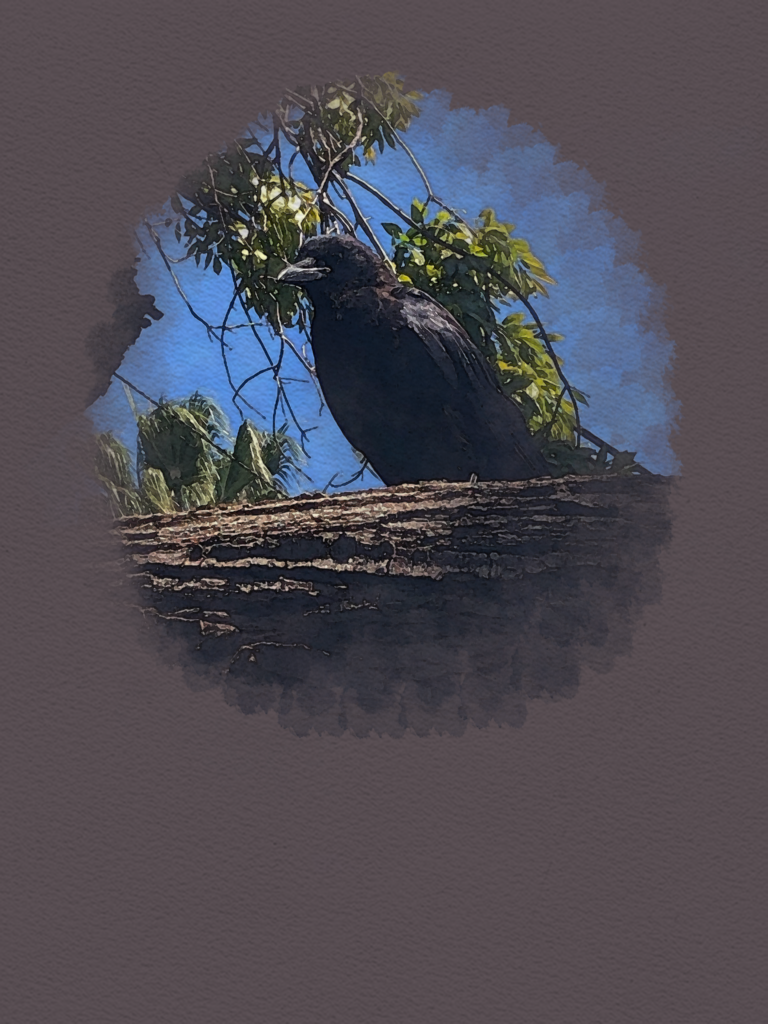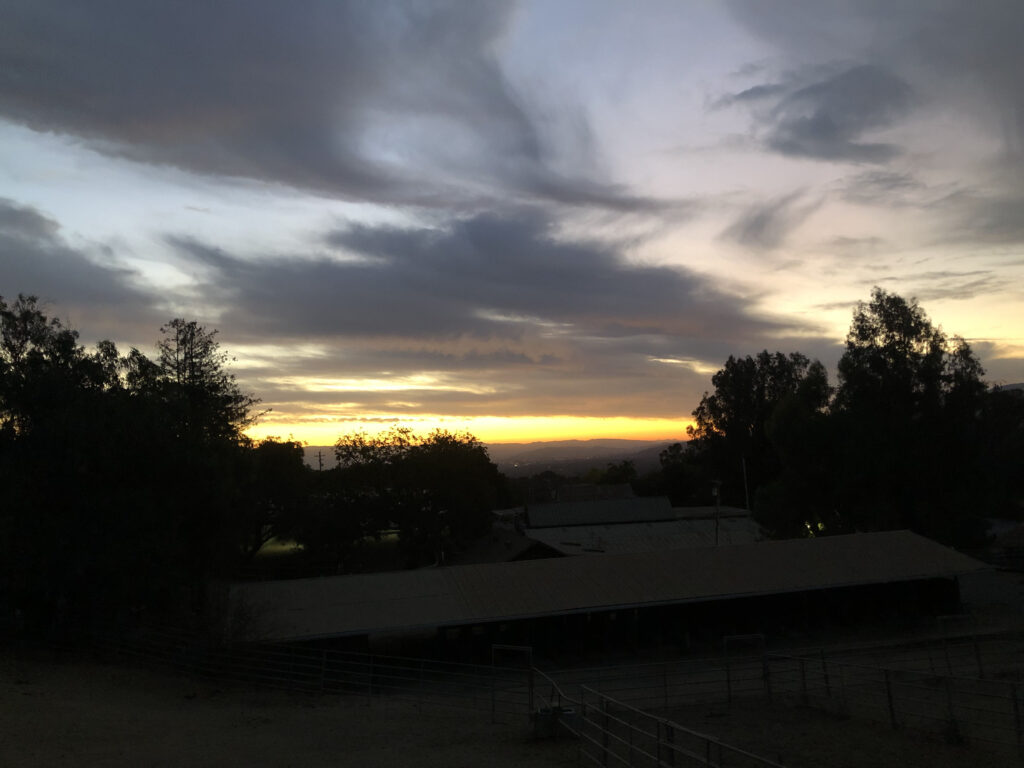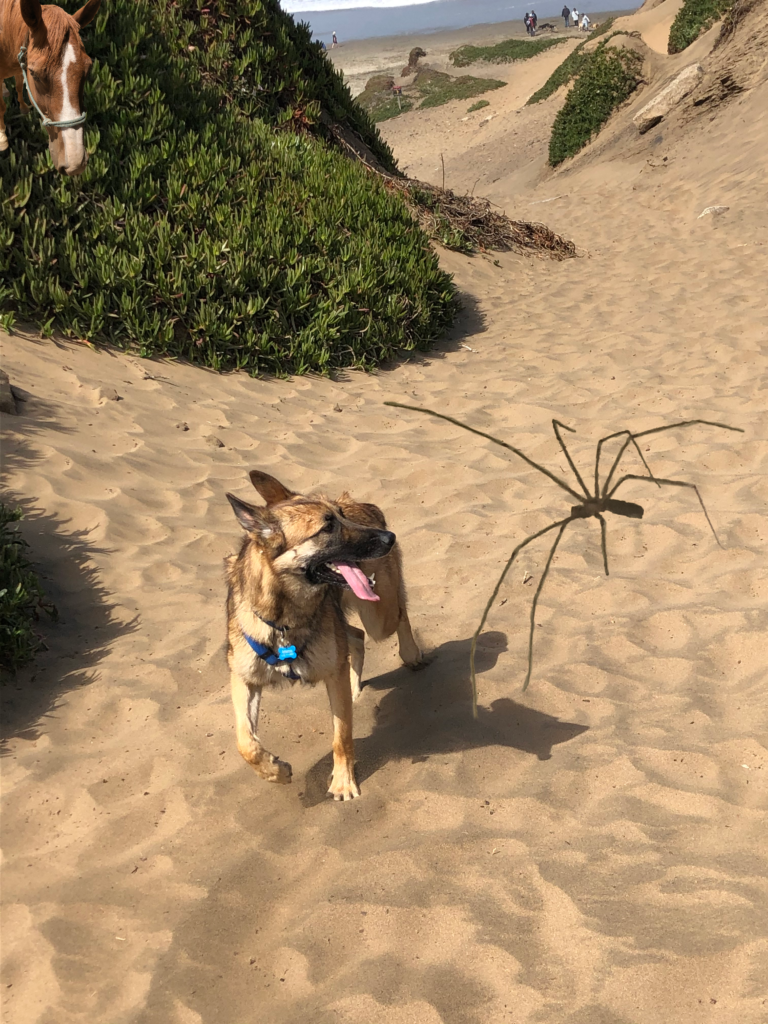Introduction
The Reflections unit is tactfully placed at the beginning of senior year, just as most of us are going through the process of college essays and applications that ask us to dig down to the core of ourselves and explain why that person is a good fit for their school. But this unit, just as is true with all of Freestyle, goes beyond college. It asked us, when school is over and you’re pursuing your dreams in the real world, what will set you apart? There are thousands, millions of people who want to become filmmakers, animators, writers, and the hundreds of other occupations that fall under “artist.” This unit forced us to ask ourselves, why would I succeed? In English we wrote personal essays to unearth our core values, in Film me made video essays that explained who we really were, and in Digital Media we created art that reflected – no pun intended – our own selves. Art really is just a reflection of the soul. Look back at what you’ve created and it’ll reveal who you are as a person.
Mandala
The Mandala project was perhaps one of my favorites from Digital Media. Through Adobe Illustrator, you could draw a line on a single section of a circle and have it reflected over to fill the shape. This allows the artist to slip into an almost meditative state of creation. The lines reflected across the canvas are almost reminiscent of ink flowing across a page.
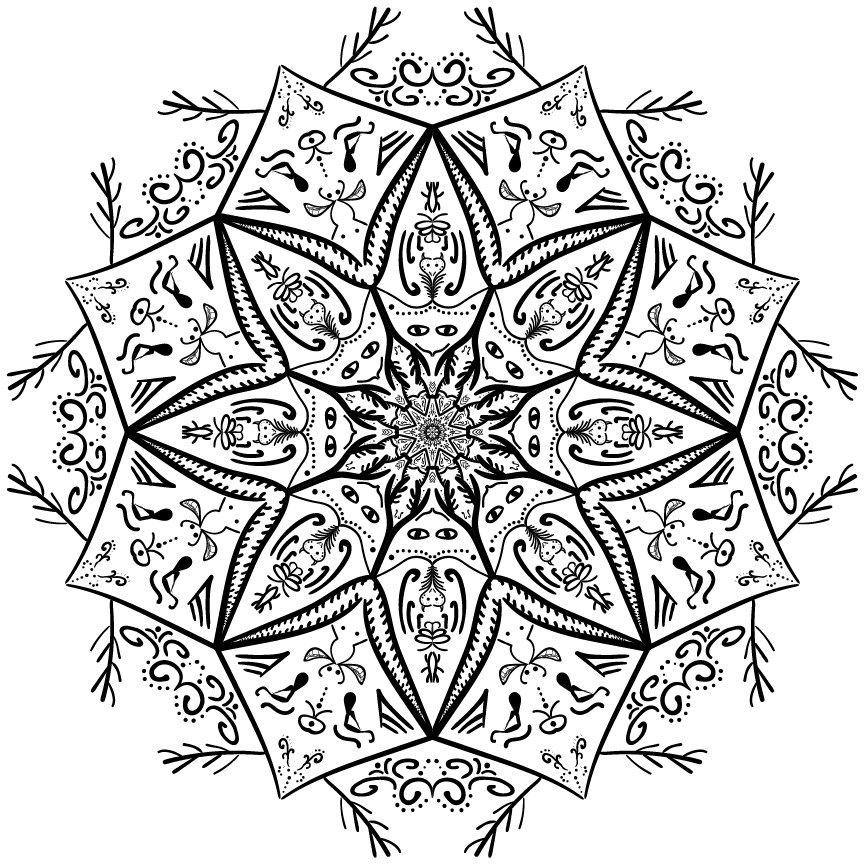
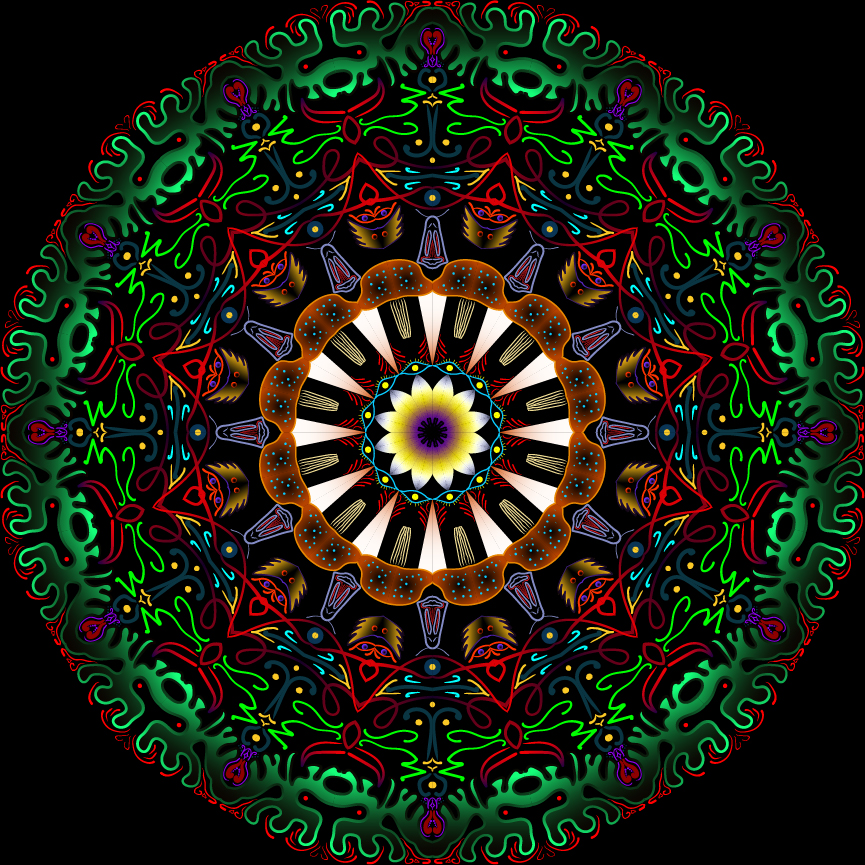
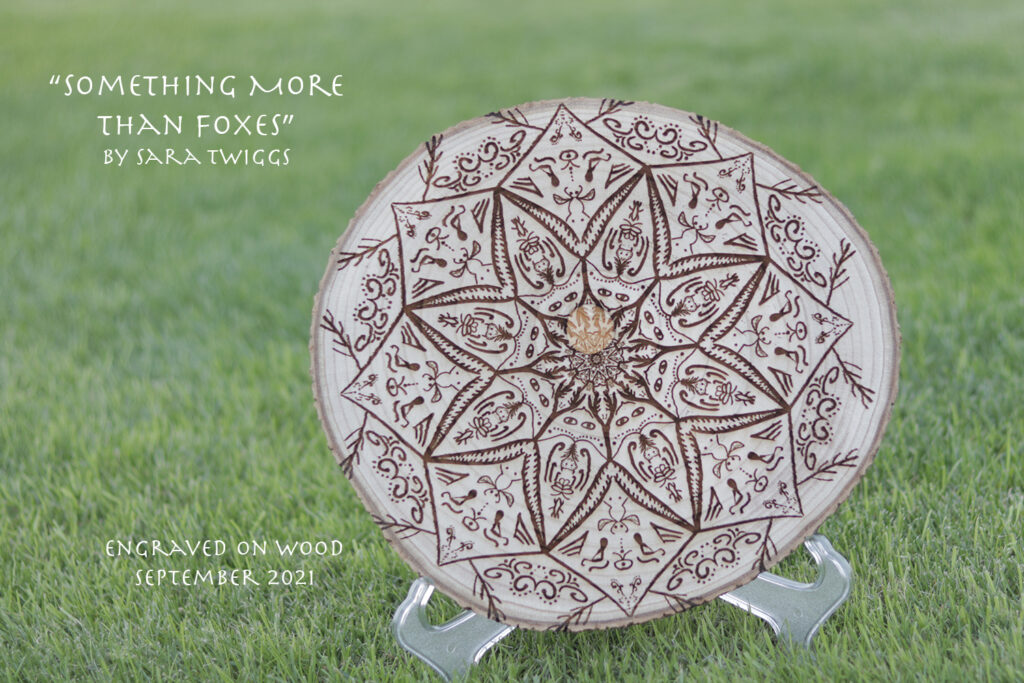
Overall, I’m pretty satisfied with what I’ve created. That’s not something I feel often, but it feels right to attribute it to this. If I were to change anything, I think I would add more detail to my colored mandala. I like it the way it is right now, but I would love for it to be the sort of piece you can look at for hours, to get lost in the result as much as I got lost in the process.
I took joy in the process of creating the mandalas. Just draw shapes and lines until something starts to make sense. Abstract, but not quite. It reflects my own style of drawing. I’m far from an artist in the traditional terms. I’ve never had the patience for an elaborate piece of art, and I’ve never had the drive to hone a style of my own. Most of my drawings are doodles in notebooks when lectures get boring and I allow my pen to wander. Both of my mandalas are the result of a restless mind and a wandering pen, and I think there’s something beautiful about that.
When I first started this project, I had an idea in mind of what I wanted to create. I saw every shape in my mind, every single pen stroke. But, as it often is with unpracticed artists, those images were unattainable. There’s something about seeing something in your head, some sort of perfection that disappears when you try to make it tangible, like a thought you can’t quite put into words. I grew frustrated with my own work. Then, one evening I pulled out my drawing tablet and began to draw. I had nothing to do, or I was procrastinating, or I had an anxious thought that just wouldn’t go away. But I drew. The lines flowed out of my pen until it became something. In the span of an hour I had created something better than I had planned. It was because I had let go of expectations for myself and my work and just let it be.
Photoshop Art
Photoshop is most well known for its photo editing, mostly for touching up imperfections. But it’s possibilities stretch far beyond that. In this unit, I learned how to paint, recreate the effect of water colors, apply that effect to existing photos, and to create images that break that boundaries of reality.
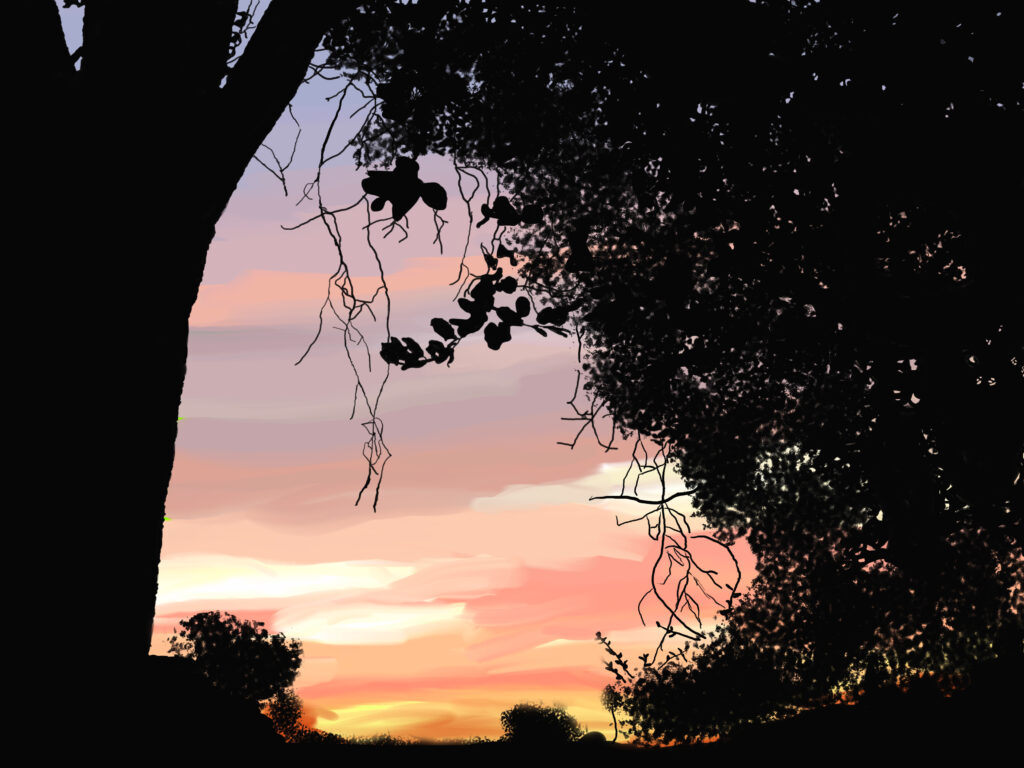
This painting is based off a photo I took in August of 2020. I was just beginning my junior year of high school from my bedroom thanks to a certain virus. As if quarantining for several months didn’t feel enough like the apocalypse, wildfires raging in Northern California turned the sky a dazzling yet frightening shade of orange. And so for a while, we all continued on with the world ending in more ways than we could count. But the sunsets. Those were beautiful enough to almost make up for it.
So when it came time to repaint a photo, I knew it had to be this one. I had tried physically painting it before, but I could never seem to capture the wildfire skies just right. To be honest, I’m not even sure if I got it right here. But Photoshop’s simple function of being able to take colors from photos unlocked a palette of brilliant colors for me. I think that’s what visual art is for me. It’s that perfect combination and blend of colors that can recreate not only the sight but the feeling of a sunset.
Although I’ve only dabbled in painting, the switch to a digital format still took some getting used to. The infinite colors were nice, and the undo button was a life saver, but it’s certainly an odd experience to paint with a pen. Adobe offers an almost overwhelming amount of brushes, yet none of them seem to be able to do what I wanted them to do. It took patience, but I was finally able to adjust. I still miss the feeling of a physical brush in my hand, but thrilled at the potential Photoshop has.
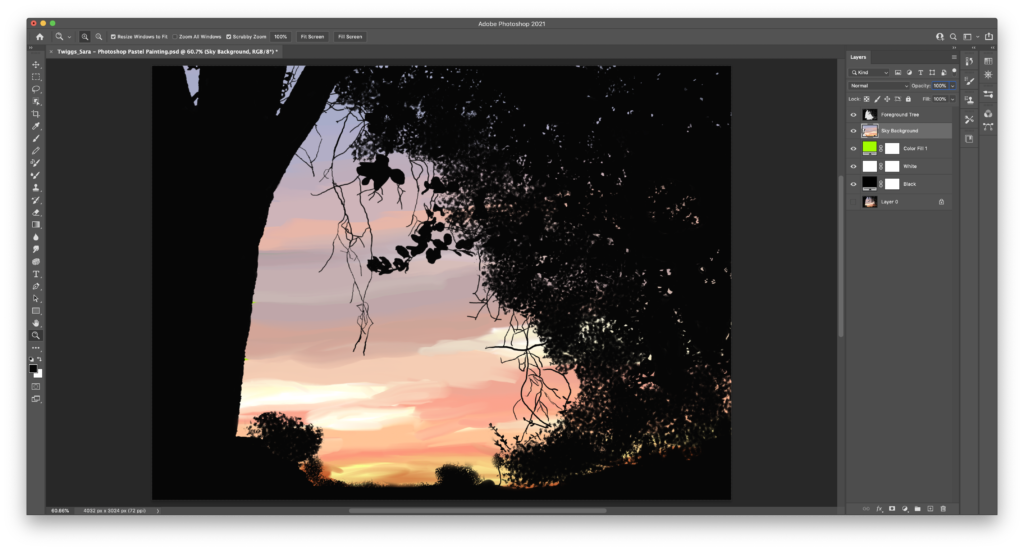
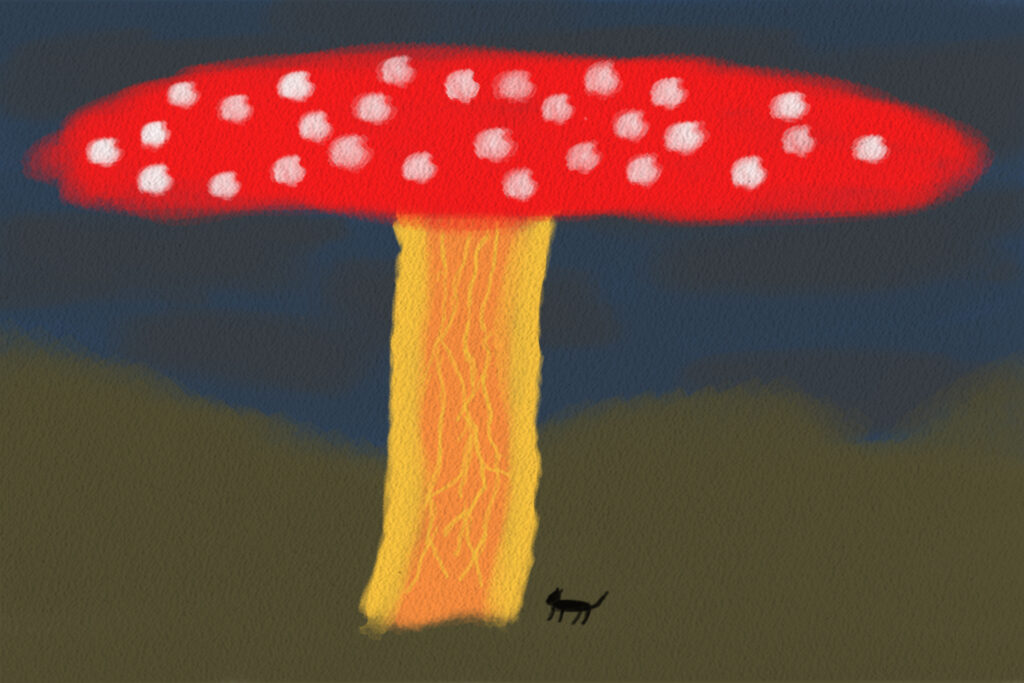
I didn’t really have much of an idea of where this piece was going to go when I started it. I painted the first thing that came to mind: a mushroom. The colors I chose for it were bright and lively, so I wanted a gloomy looking background for it. As I kept going, the mushroom began to look almost like a tree. The mushroom was a radiant haven in a drab, overcast world. And if there is a haven, it needs someone to protect. The animal is ambiguous on purpose. Dog, cat, something else entirely – it doesn’t really matter. What does matter is that it’s small and safe under a big ol’ mushroom. And I think that’s neat.
I think digital and analog painting have their own values. Digital painting is far easier to create a specific piece. You can erase or undo or put it on another layer. It’s the best method if you’re looking to take an image from your head and make it real. Analog painting is far less forgiving. Each mistake is permanent, you have to mix your own colors, and there’s no undoing a stroke that came out a little shaky. But digital painting lacks the joy of putting paint on canvas. Every color mixed, every stroke of the brush is a risk. It may go wrong, yes, but the accidental result may be more interesting than the intention. Digital painting is safe, but safe is not always what art needs.
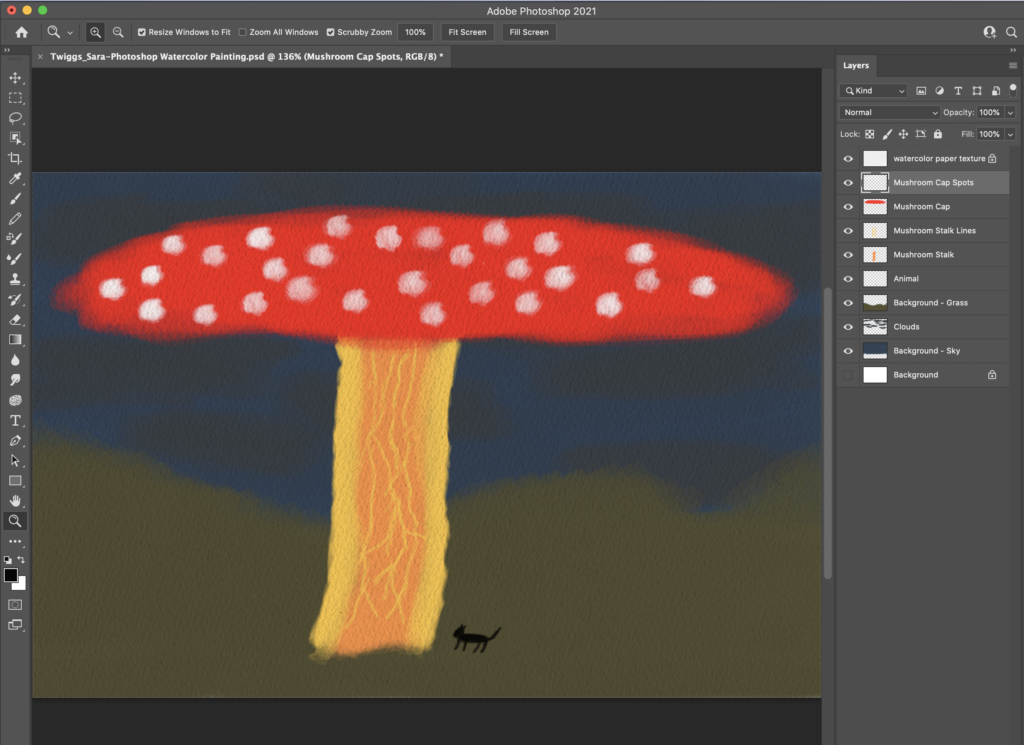
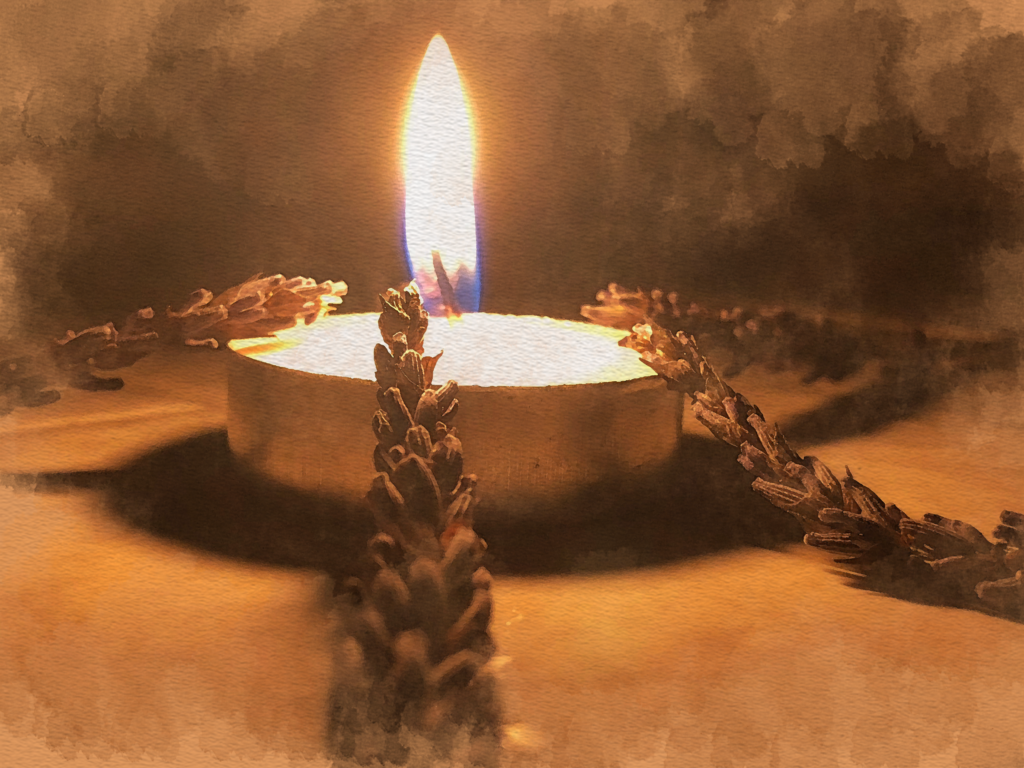
If you’ve seen my work, you may recognize the first photo from my haiku. I took that photo to convey the feeling of being on the edge of disaster, but it has since stuck with me for its interesting dichotomy of light and shadows. Fun fact: one of those stalks of lavender did get slightly singed. The second picture is of my beloved dog Artemis. It was taken one morning while everyone in the house was getting ready for school or work. You can see how desperate she is to be taken with us. The third and final image is of a crow I met one my way to class. I’ve always wanted to befriend a crow and this one didn’t seem particularly startled by me, so I followed it around for a bit. I didn’t have anything to feed it, so the only thing that resulted from that interaction was me almost being late to class.
I think it’s fascinating that technology can recreate traditional styles of art. I explored a little bit into what other effects can be added to photos. I found effects that emulated not only different styles of painting, but also specific techniques of drawing, like the use of cross-hatching.
I am not much of an artist in the traditional sense. I can’t draw or paint very well, but I do enjoy photography. It’s interesting to think that I could use my skills of one medium to replicate the style of another, especially one I may not be as talented at.

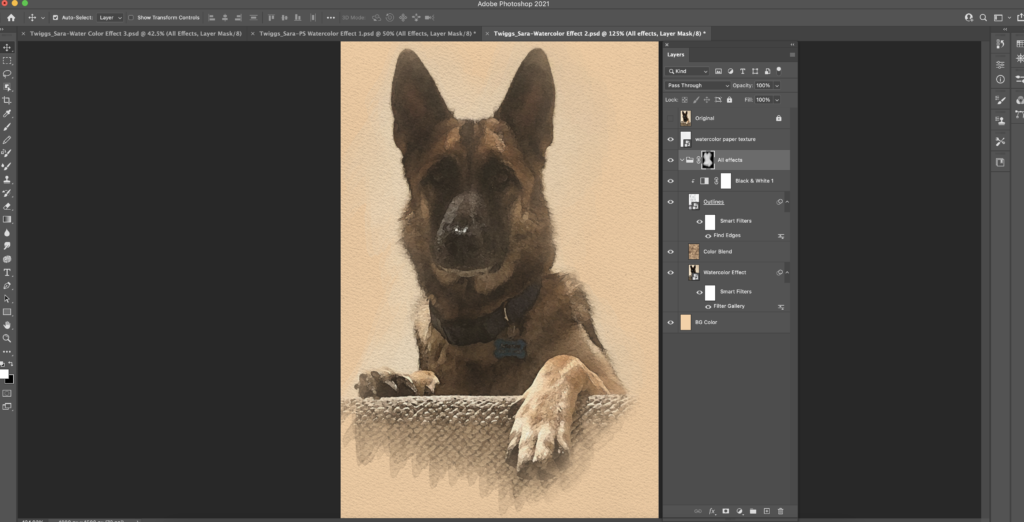

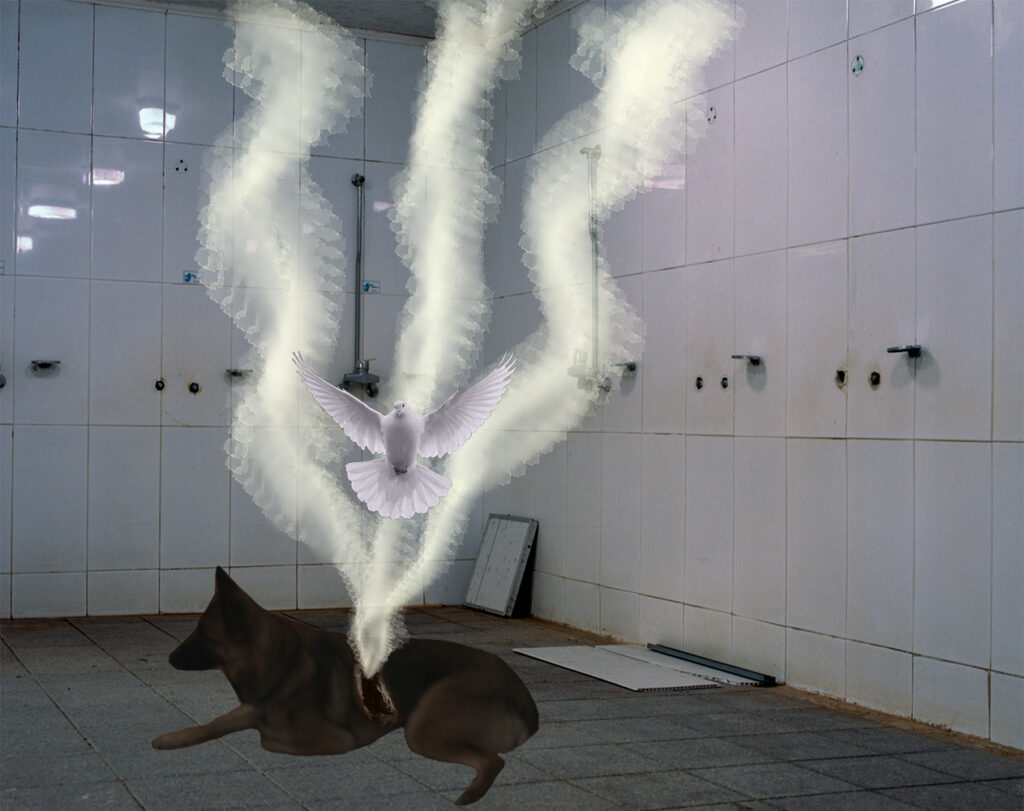
I’m not exactly sure of the message I’m trying to convey with this piece. In an earlier idea, a black ooze would pour out instead of the light rising up like smoke. In that draft, eyes growing out of the walls watched on. It was supposed to convey the feeling of the worst parts of yourself spilling out of you for all to see. But in this iteration, there is instead light surrounding a dove, the universal symbol for peace. This version conveys a more hopeful method, I think. Perhaps it shows a peace that can be found even in the darkest spots.
One of my favorite techniques was changing the color of a single aspect of the image. It makes each image I’ve added seem like it fits into the scene. It also allowed me to turn a picture of a split pomegranate into something that looks like a wound on the dog. That little fact has to be one of my favorite easter eggs in this image.
Surrealism has to be one of my favorite genres. It challenges the rational mind and ventures into the wonderful realm of absurdity. So when it comes to surreal versus realistic compositions, it’s hardly a question. Realistic compositions do have their uses, but it seems that for the most part it’s about fixing a flaw or adding something you want to be there. Realistic compositions are a supplement to photography. Surreal compositions, on the other hand, build off of art and photography to become an entirely new medium.

Film
In Film, we wrote and filmed short personal video essays. Whereas the English essays examined our core values, these videos were meant to delve into who we are.
I found the video essay especially interesting because it was my first experience with writing any form of script for a video. To be perfectly honest, I believe I am a stronger writer than filmmaker. So an opportunity to flex my writing muscles is always enjoyable. And even so, this project allowed me to make more than words on a page. I was able to make them not quite tangible, but something close to it.
English Personal Essay
In English, our first assignment was a personal essay. This essay was intended to function as a college essay and created through the lens of such criteria, but the result is far more valuable than something to be sent to colleges and forgotten about. It is the sort of in depth reflection in which the author learns as much about themself in the process of writing as the audience does in reading. For example, I examined my experiences with depression and anxiety and how it intersected with my writing. I found that my writing and its tone mirrored my mental health. It was my own form of coping that allowed me to sort out my emotions without having to deal with them myself.
You can read the essay here.
